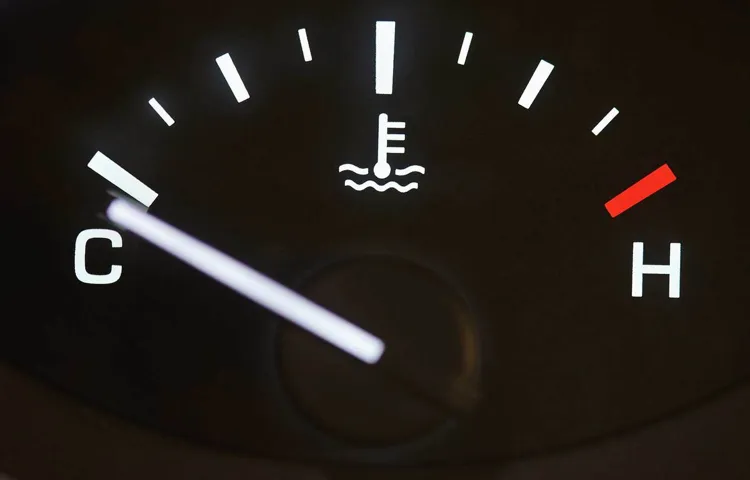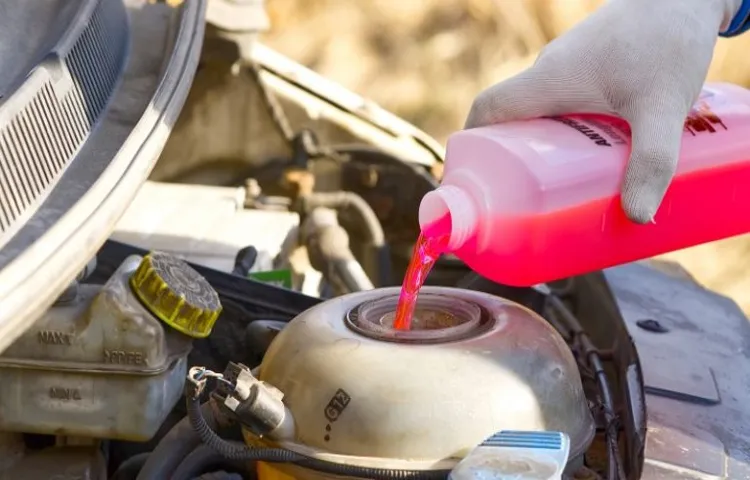Do you know what happens under the hood of your car? One of the essential components that you should pay attention to is the coolant temperature. It plays a crucial role in keeping your engine running smoothly and preventing it from overheating. Think of coolant temperature as the body temperature of your car’s engine.
Just like how your body needs to stay within a certain temperature range to function optimally, so does your engine. In this blog post, we will take a closer look at what coolant temperature is, why it is important, and how to monitor it effectively. So, buckle up and let’s dive into the world of coolant temperature!
Table of Contents
What is Coolant Temperature?
What should the coolant temp be? Well, the ideal coolant temperature for most vehicles is between 195°F and 220°F (90°C to 105°C). This range ensures that the engine operates at its most efficient level and that the coolant is able to regulate the engine’s temperature effectively. If the coolant temperature is too low, the engine may not reach optimal operating temperatures, leading to decreased fuel efficiency and increased emissions.
On the other hand, if the coolant temperature is too high, it can cause the engine to overheat and potentially cause damage. It’s important to regularly check the coolant level and ensure that it is at the right temperature to keep your engine running smoothly. If you’re uncertain about what the ideal coolant temperature should be for your specific vehicle, it’s always best to consult your owner’s manual or speak to a trusted mechanic.
Definition and Importance
coolant temperature, engine coolant, engine temperature Coolant temperature refers to the temperature of the engine coolant in a vehicle’s cooling system. The coolant is a liquid mixture that circulates through the engine, absorbing the heat generated by the combustion process. It plays a crucial role in preventing the engine from overheating and maintaining its optimal operating temperature.
The coolant temperature is monitored by a sensor that sends signals to the vehicle’s onboard computer, which then adjusts the engine’s fuel mixture and ignition timing accordingly. This ensures that the engine operates efficiently and avoids any potential damage due to overheating. Maintaining the proper coolant temperature is essential for the overall health and performance of the engine.
If the engine runs too hot, it can lead to components such as the piston rings, cylinder wall, and valves being damaged. On the other hand, if the engine runs too cool, it can result in poor fuel efficiency and increased emissions. Regularly monitoring the coolant temperature gauge and addressing any issues promptly can help prevent costly repairs and ensure the longevity of the engine.
It is important to keep an eye on the coolant level and quality, as well as regularly flushing and replacing the coolant as recommended by the vehicle manufacturer. In summary, coolant temperature is a critical factor in maintaining the proper functioning of a vehicle’s engine. It is important to monitor and regulate the coolant temperature to avoid overheating or running too cool, as both can lead to costly engine damage.
Regular maintenance and attention to the coolant system can help keep the engine running smoothly and efficiently.

Normal Operating Range
“What should the coolant temp be?” is a common question among car owners. The coolant temperature is an important indicator of your vehicle’s health and can vary depending on the make and model. Generally, the normal operating range for coolant temperature is between 195 and 220 degrees Fahrenheit (90 to 105 degrees Celsius).
This range is considered optimal for efficient combustion and engine performance. If the coolant temperature is too low, it may indicate a problem with the thermostat or heater core. On the other hand, if the temperature is too high, it could be a sign of a cooling system malfunction, such as a faulty radiator or water pump.
Monitoring the coolant temperature is crucial to prevent overheating, which can cause engine damage. It’s recommended to check the coolant temperature gauge regularly and pay attention to any sudden fluctuations or unusual readings. If you notice the temperature consistently outside of the normal range, it’s advisable to have your vehicle inspected by a qualified mechanic.
In conclusion, the normal operating range for coolant temperature is between 195 and 220 degrees Fahrenheit. Keeping an eye on the coolant temperature can help you ensure the health and longevity of your vehicle’s engine.
Ideal Coolant Temperature
coolant temperature, normal operating range
Acceptable Coolant Temperature Range
acceptable coolant temperature range, normal operating range In order to keep your vehicle running smoothly, it’s important to understand the acceptable coolant temperature range. The coolant plays a crucial role in regulating the engine’s temperature and preventing it from overheating. The normal operating range for coolant temperature is typically between 195°F and 220°F (90°C and 105°C).
This range allows the engine to heat up efficiently and maintain a stable temperature during regular driving conditions. However, it’s important to note that the specific acceptable range can vary depending on the make and model of your vehicle. Some vehicles may have a slightly higher or lower range, so it’s always best to consult your owner’s manual for the correct temperature range for your specific vehicle.
Monitoring your coolant temperature and ensuring it stays within the acceptable range can help prevent engine damage and costly repairs down the line.
Effects of Overheating
effects of overheating, normal operating range
Factors Affecting Coolant Temperature
What should the coolant temp be? The coolant temperature in a vehicle is an important factor to monitor as it can affect the overall performance of the engine. The ideal temperature for the coolant can vary depending on the make and model of the vehicle, but generally, it should be between 195 to 220 degrees Fahrenheit (90 to 105 degrees Celsius). This range allows the engine to operate efficiently and minimizes the risk of overheating.
However, it’s essential to note that different factors can affect the coolant temperature, including the outside temperature, engine load, and driving conditions. For example, during hot summer days or in heavy traffic, the coolant temperature may rise slightly higher due to increased demand on the engine. On the other hand, during cold winter days, the coolant temperature may take longer to reach the desired operating range.
It’s crucial to pay attention to any sudden or significant changes in the coolant temperature, as this could indicate a problem with the cooling system, such as a faulty thermostat or a leak. Regularly checking the coolant level and ensuring it is at the appropriate mixture of antifreeze and water is also essential to maintain the correct coolant temperature.
Ambient Temperature
ambient temperature, coolant temperature, factors affecting coolant temperature When it comes to keeping our cars running smoothly, the temperature of the coolant is a crucial factor. The coolant helps to regulate the engine’s temperature, preventing overheating and ensuring optimal performance. But did you know that the ambient temperature can have a significant impact on the coolant temperature? The ambient temperature refers to the temperature of the surrounding environment, be it a scorching summer day or a chilly winter morning.
In hot weather, the coolant temperature can rise, putting extra strain on the engine. On the other hand, in cold weather, the coolant temperature can drop, potentially causing the engine to run less efficiently. So, what are the factors that affect coolant temperature in relation to ambient temperature? One of the main factors is the cooling system of the vehicle.
A well-maintained cooling system with clean radiator fins and a strong coolant flow can help dissipate heat from the engine more effectively, keeping the coolant temperature at an optimal level. Another factor is the type of coolant used. Some coolants have higher boiling points, making them more suitable for hotter ambient temperatures.
Additionally, the size and design of the radiator, as well as the placement of the engine, can influence how well the coolant maintains its temperature. So, while we can’t control the ambient temperature, we can ensure that our cooling systems are in good shape and that we use the right coolant for the conditions. By keeping an eye on our coolant temperature, we can help prolong the life of our engines and ensure they perform at their best, regardless of the weather outside.
Engine Load
Engine Load, Factors Affecting Coolant Temperature
Cooling System Efficiency
In order to maintain the optimal operating temperature in a vehicle, it is important to understand the factors that can affect the coolant temperature. One of the main factors that can impact the coolant temperature is the efficiency of the cooling system. The cooling system works by circulating coolant through the engine to absorb the excess heat and then transferring that heat to the radiator where it can be dissipated.
If the cooling system is not functioning properly, it can result in overheating and potential damage to the engine. There are several factors that can contribute to a decrease in cooling system efficiency. One such factor is a malfunctioning thermostat.
The thermostat is responsible for regulating the flow of coolant through the engine. If it becomes stuck or fails, it can cause the coolant to become stagnant and lead to overheating. Another factor that can impact cooling system efficiency is a clogged radiator.
Over time, debris and contaminants can build up in the radiator, obstructing the flow of coolant and reducing its ability to dissipate heat. Additionally, a worn-out water pump can also contribute to decreased cooling system efficiency. The water pump is responsible for circulating the coolant through the system, and if it is not functioning properly, the coolant may not flow efficiently, resulting in poor heat transfer.
Regular maintenance and inspections of the cooling system components can help identify and address any issues that may be affecting its efficiency.
Thermostat Operation
thermostat operation, coolant temperature, factors affecting coolant temperature One of the essential components of a car’s cooling system is the thermostat. It plays a crucial role in regulating the engine’s coolant temperature to ensure optimal performance and prevent overheating. However, several factors can affect the coolant temperature and how the thermostat operates.
For starters, the outside temperature has a significant impact on the engine’s temperature. In hot weather, the coolant needs to work harder to cool down the engine, while in cold weather, it takes longer for the engine to reach its ideal temperature. The engine load is another factor to consider.
When the car is running at high speeds or hauling heavy loads, the engine generates more heat, increasing the coolant temperature. On the other hand, idling for extended periods or driving in stop-and-go traffic can cause the coolant temperature to drop. Another factor affecting the thermostat operation is the condition of the cooling system.
If there are any leaks or blockages in the radiator or hoses, the coolant may not circulate properly, leading to irregular coolant temperature. Additionally, the thermostat itself can malfunction due to wear and tear or being stuck in the open or closed position. Regular maintenance and inspections can help identify and address any issues with the cooling system and thermostat, ensuring the engine runs at the optimal temperature for reliable performance and longevity.
Monitoring Coolant Temperature
One of the most important factors in maintaining the health of your car’s engine is monitoring the coolant temperature. But what should the coolant temp be? Well, the ideal operating temperature for most engines is around 195 to 220 degrees Fahrenheit (90 to 105 degrees Celsius). This temperature range allows the engine to operate efficiently and effectively without overheating or causing damage.
However, it’s important to note that different vehicles may have slightly different temperature ranges, so it’s always best to consult your owner’s manual for the specific coolant temperature recommendations for your car. Additionally, it’s important to regularly monitor the coolant temperature gauge on your dashboard while driving to ensure that it stays within the optimal range. If you notice that the coolant temperature is consistently too high or too low, it may be a sign of an underlying issue that needs to be addressed by a professional mechanic.
So, keep a close eye on your coolant temperature to keep your engine running smoothly.
Coolant Temperature Gauge
coolant temperature gauge, monitoring coolant temperature One important aspect of maintaining a car’s engine is to monitor the coolant temperature. This can be done through the use of a coolant temperature gauge, which provides valuable information about the engine’s operating temperature. The coolant temperature gauge is usually located on the dashboard of a car and is designed to give the driver a visual representation of how hot or cold the engine is running.
By monitoring the coolant temperature gauge, drivers can ensure that the engine is operating within the optimal temperature range. This is important because if the engine gets too hot, it can cause damage to essential components and may even lead to a breakdown. On the other hand, if the engine is running too cold, it may not be operating efficiently and may result in poor fuel economy.
By keeping an eye on the coolant temperature gauge, drivers can easily detect any abnormal temperature fluctuations and take timely action to prevent potential problems. So, the next time you get behind the wheel, don’t forget to keep an eye on your coolant temperature gauge; after all, it’s a small instrument that can make a big difference in the health and performance of your car’s engine.
Coolant Temperature Sensor
coolant temperature sensor, monitoring coolant temperature. Did you know that your car’s engine has a built-in temperature monitor? It’s called a coolant temperature sensor, and it plays a crucial role in keeping your engine running smoothly. The coolant temperature sensor measures the temperature of the engine coolant and sends that information to the engine control unit (ECU).
This allows the ECU to adjust factors like fuel injection, ignition timing, and air-fuel mixtures to optimize performance and efficiency. Think of the coolant temperature sensor as the engine’s own personal thermostat. Just like how a thermostat regulates the temperature in your home, the coolant temperature sensor helps regulate the temperature in your engine.
So, the next time you’re driving and notice that the temperature gauge on your dashboard is creeping into the danger zone, rest assured that the coolant temperature sensor is hard at work, keeping your engine in check. It’s a small but mighty component that plays a big role in keeping your car running smoothly.
Maintaining Optimal Coolant Temperature
When it comes to maintaining your car’s optimal coolant temperature, it’s essential to know what the ideal range should be. The coolant temperature should typically be around 195 to 220 degrees Fahrenheit (90 to 105 degrees Celsius). This range is considered ideal because it allows the engine to run efficiently without getting too hot or too cold.
If the coolant temperature is too low, it can lead to poor fuel economy, engine wear, and increased emissions. On the other hand, if the coolant temperature is too high, it can cause overheating, engine damage, and even a breakdown. Therefore, it’s crucial to keep an eye on your car’s coolant temperature gauge and address any issues promptly if it falls below or exceeds the recommended range.
Regular maintenance, such as checking the coolant level, flushing the system, and inspecting for leaks, can help ensure that your car maintains the optimal coolant temperature. So, the next time you wonder what the coolant temp should be, remember that it’s all about keeping your engine running smoothly and preventing any potential problems.
Regular Maintenance
Regular maintenance is essential for keeping your vehicle in optimal condition, and one crucial aspect of this is maintaining the coolant temperature. The coolant in your car’s engine is responsible for keeping it from overheating, which can cause serious damage. To ensure that your car’s coolant temperature is always within the recommended range, it’s important to regularly check the coolant level and condition.
This can be done by visually inspecting the coolant reservoir and adding more coolant if needed. Additionally, it’s a good idea to have the coolant system flushed and refilled according to the manufacturer’s recommendations. By keeping the coolant temperature at the right level, you can prevent overheating and extend the lifespan of your vehicle.
So, don’t neglect this important aspect of regular maintenance.
Checking Coolant Level
coolant level, coolant temperature
Flushing and Filling Coolant
In order to maintain optimal coolant temperature in your car, it’s essential to flush and fill the coolant regularly. Coolant, also known as antifreeze, plays a crucial role in regulating the temperature of your engine, especially during hot summer months or freezing winter conditions. Over time, coolant can become contaminated with dirt, rust, and other debris, which can significantly affect its effectiveness.
By flushing out the old coolant and refilling it with fresh coolant, you can ensure that your engine remains properly cooled and protected against overheating or freezing. Think of it like giving your car’s engine a refreshing drink to keep it running smoothly. So, if you’re noticing any signs of overheating or the coolant seems discolored or dirty, it’s time to flush and fill your coolant to keep your car’s engine in top-notch condition.
Inspecting Cooling System Components
cooling system components, maintain optimal coolant temperature
Conclusion
So, to sum it all up, what should the coolant temp be? Well, it should be just right, like Goldilocks finding the perfect bowl of porridge. Too hot, and you risk overheating your engine, causing all sorts of damage like a diva throwing a temper tantrum. Too cold, and your car will be about as useful as a frozen popsicle on a summer day.
The ideal coolant temp is a delicate balance, like a tightrope walker gracefully tiptoeing across a wire. It should be warm enough to keep your engine functioning efficiently, like a well-oiled machine. But not too warm that it turns your car into a steamy sauna, leaving you feeling hotter than a jalapeno pepper on a sun-soaked day.
Think of your coolant temp as the Goldilocks zone of your car’s performance. It needs to be just right, like a perfectly brewed cup of coffee, to keep everything running smoothly. Too low and you’re in the danger zone, like driving with one eye closed and a blindfold on.
Too high and you’re risking a meltdown, like a volcano about to blow its top. So, in conclusion, the coolant temp should be the Goldilocks of your car’s performance – not too hot, not too cold, but just right. Take good care of it, and your engine will thank you with a smooth and efficient experience on the road.
Remember, it’s all about finding that sweet spot, like hitting the perfect note in a symphony or scoring a goal in a penalty shootout. Keep it cool, my friends!”
FAQs
What should the coolant temperature be for a car engine?
The ideal coolant temperature for most car engines is between 195 and 220 degrees Fahrenheit.
Is it normal for the coolant temperature to fluctuate while driving?
It is normal for the coolant temperature to fluctuate slightly while driving, as long as it stays within the recommended range for your specific vehicle.
What can cause the coolant temperature to rise quickly?
Several factors can cause the coolant temperature to rise quickly, including a malfunctioning thermostat, a coolant leak, or a faulty radiator fan.
Is it safe to drive a car if the coolant temperature is too high?
It is not safe to drive a car if the coolant temperature is too high. Continued driving with an overheated engine can cause severe damage to the engine components.
How can I check the coolant temperature in my car?
Most modern cars have a coolant temperature gauge on the dashboard that indicates the temperature. Alternatively, you can use an OBD-II scanner to read the coolant temperature data.
What should I do if my car’s coolant temperature is constantly low?
If your car’s coolant temperature is constantly low, it may indicate a problem with the thermostat or the coolant temperature sensor. It is recommended to have it inspected by a mechanic.
What is the purpose of the coolant temperature sensor?
The coolant temperature sensor is responsible for monitoring the temperature of the coolant and sending the information to the car’s engine control unit (ECU). The ECU uses this data to make adjustments to the engine’s performance.



